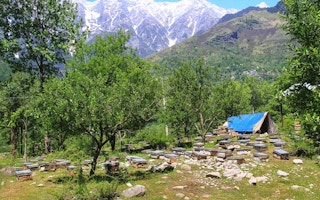February snowfall in the middle reaches of the Hindu Kush Himalayas is not uncommon. But coming at the tail of an unusually mild and dry winter, it has hit apple farmers whose trees were flowering early, while maize growers are hoping they will be able to save some of the crop hit by lack of water.
Down in the plains — where the snowfall turned into a drizzle — farmers growing mustard, pulses or vegetables in non-irrigated fields do not think they will be able to salvage much. The unusually mild and dry winter hit them at the growing season, and a late drizzle is not really going to help.
In the high mountains, the mild winter has already led to a major tragedy — an ice wall collapsed and buried an Indian Army outpost in the Siachen glacier, killing ten soldiers.
Scientists say all this is due to a combination of climate change and a particularly severe El Niño Southern Oscillation, which affected most of the Indian Ocean and led to two successive droughts in South Asia.
The World Meteorological Organisation (WMO) and the US National Oceanic and Atmospheric Administration (NOAA) reported that the global average temperature over land and ocean for 2015 was the highest since record keeping began. The combined global land and ocean average surface temperature for December was the highest for any month recorded, and 2011-15 was the warmest five-year period on record.
A WMO analysis indicated that the global average surface temperature in 2015 broke all previous records by a margin of 0.76±0.1 degrees Celsius above the 1961-90 average. Also, for the first time on record, temperatures in 2015 were a degree Celsius above pre-industrial levels. According to the NOAA, in 2015 the record warmth was broadly spread around the world.
Petteri Taalas, WMO Secretary-General, said “an exceptionally strong” El Niño and global warming caused by greenhouse gases (GHGs) had a compound effect on the climate system in 2015. “The power of El Niño will fade in the coming months,” he noted, “but the impacts of human-induced climate change will be with us for many decades. We have reached for the first time the threshold of one degree Celsius above pre-industrial temperatures. It is a sobering moment in the history of our planet.”
Scientists say the current El Niño has probably reached its peak. The NOAA said by the summer of 2016, the tropical Pacific might be back in a neutral state or La Niña cooling could kick in, as it did after major El Niños of the past. But since the planet is hotter than at any time in the past 135 years, it was respond if the ocean would respond in 2016 in the same way as it did after the 1998 and 1983 El Niños.
Fifteen of the 16 hottest years on record have all been this century, with 2015 being significantly warmer than the record-level temperatures seen in 2014. The record temperatures over both land and the ocean surface in 2015 were accompanied by heatwaves, floods and severe drought.
“Climate change will have increasingly negative impacts for at least the next five decades. This emphasises the need to invest in adaptation besides mitigation. It is important to strengthen the capability of countries to provide better disaster early warnings to minimize human and economic losses. Climate change increases the risk of weather related disasters which are an obstacle to sustainable development,” Taalas said.
The warmer weather and climate extremes have not only affected South Asia. In 2015, Europe experienced its second warmest year after 2014 and Africa its second warmest after 2010, while Asia and South America had its warmest year on record in 2015.
For 2015, annual precipitation was just below average on balance for land-based rain gauges around the world. There were extreme precipitation and drought events in many places.
The South Asian summer monsoon made its annual onset over Kerala on June 5, just a few days later than normal. Rainfall for the seasonal period June 1 to September 30 was 86 per cent of the 1951-2000 average. About half of India received normal rainfall, while the other half received deficient rainfall (less than 80 per cent of average). This marks the fourth time in the 115-year record that two consecutive years have been below average.
The WMO said the trend of increasingly extreme and frequent weather that matched climate change forecasts had been put into stark perspective by the latest data. Meanwhile the economic impact of one of the strongest El Niño’s on record is a warning of worse to come if the world does not act fast enough to cut the concentrations of GHGs in the atmosphere.
No single weather event can be attributed to climate change but the frequency and intensity of extreme weather events is increasing as predicted as global average temperatures rise, and this will have severe economic implications.
Coal, oil and heat
In a new study published to coincide with the WMO’s findings, an international team of scientists said that without GHG emissions from burning coal and oil, “the odds are vanishingly small that 13 out of the 15 warmest years ever measured would all have happened in the current, still young century.” The odds ranged between 1 in 5,000 and 1 in 170,000.
“Natural climate variability causes temperatures to wax and wane over a period of several years, rather than varying erratically from one year to the next,” said lead author Michael Mann, director of the Earth System Science Centre in Penn State.
Stefan Rahmstorf of the Potsdam Institute for Climate Impact Research said: “Natural climate variations just can’t explain the observed recent global heat records, but man-made global warming can.”
A recent study published in the journal Nature showed that droughts and extreme heat have cut cereal production by 9-10 per cent on average around the world in the last half-century, and the impact has worsened since the mid-1980s.










